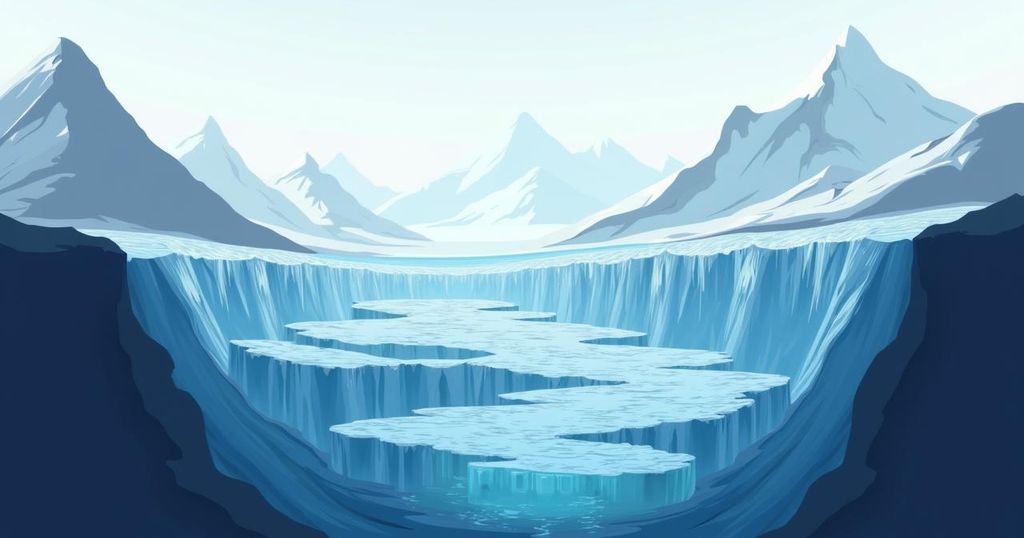The Vital Role of Rock Glaciers in a Warming Climate
Scott Hotaling, a mountain ecologist, explores rock glaciers in the Wasatch Mountains, highlighting their resilience to climate change. Rock glaciers, often overlooked, are more abundant than traditional glaciers and play a crucial role in supplying water to arid regions. Recent research indicates that they provide significant water stores, essential for supporting local ecosystems amid declining winter snowpack.
In the Wasatch Mountains near Salt Lake City, Utah, a trail meanders through dense forests leading to the serene White Pine Lake. Scott Hotaling, a mountain ecologist at Utah State University, forgoes the lake to venture up the terrain towards a significant geological feature: a rock glacier. These glaciers, distinct from their snowy counterparts, comprise large masses of ice enveloped by a covering of rocks. Known for their insulating properties, rock glaciers are exhibiting resilience in the face of climate change, largely due to their debris cover which shields them from rising temperatures. Hotaling points out that while surface ice is rapidly diminishing, rock glaciers are “holding steady amidst widespread ice decline.” Their stability is critical as these glaciers represent major water sources for arid regions like Utah, where traditional snowpack levels are in decline. Throughout the western United States, over 10,000 rock glaciers exist—double the number of typical glaciers—yet they remain largely overlooked in scientific research. Hotaling notes that a significant portion of rock glacier studies has historically originated from European contexts, especially the Alps, where proximity to human activity raises concerns about debris falls. A notable study traced a specific rock glacier in the Alps over seventy years, revealing minimal changes in ice mass compared to rapidly retreating surface glaciers. Despite evidence suggesting some movement in U.S. rock glaciers, they still demonstrate greater resilience against climate impacts. In fact, recent studies in the Teton Range found that surface glaciers were melting approximately seven times faster than nearby rock glaciers, indicating that rock glaciers will likely dominate future mountain landscapes as traditional glaciers vanish. Public awareness about rock glaciers remains limited. During his presentations, Hotaling often finds that few attendees have prior knowledge of this phenomenon. For instance, many hikers frequent areas like White Pine Lake without recognizing the rock glaciers nearby, which can easily be mistaken for ordinary rock formations. The challenges posed by the unique structure of rock glaciers present complications in studying their composition. Hotaling expresses the desire for better methods to assess the ice content within these glaciers. Accessing the ice trapped beneath layers of rock is a meticulous endeavor, with few opportunities for retrieval. Collaborators, such as geologist Matthew Morriss, have successfully managed to collect valuable samples in previous instances but such occurrences are rare. The investigation of meltwater from rock glaciers presents a more tangible focus of study. Hotaling and technician Kendall Becker are particularly interested in how this water contributes to mountain streams and sustains local ecosystems. Recent research indicates that rock glaciers hold “globally significant water stores,” which can substantially influence water availability in regions like Utah during arid seasons. The water emanating from the glacier is crucial, with examples such as over half of Salt Lake City’s drinking water originating from canyons concealing various rock glacier formations. The significance of these glaciers—notably their overlooked prevalence in ecosystems—should not be understated. The varied locations throughout Little Cottonwood Canyon are filled with underappreciated rock glaciers that may play a pivotal role in regional water resources and animal habitats, indicating a need for heightened awareness and research about these unique formations.
Rock glaciers are large ice masses cloaked with debris, allowing them to withstand warmer climate conditions better than traditional glaciers. They serve as essential water reservoirs for affected regions in the context of climate change, which is shrinking standard snowpacks. The unique characteristics of rock glaciers position them as subjects of renewed scientific interest, especially as traditional glaciers continue to retreat in response to rising global temperatures. Despite their prevalence, notably in mountainous areas of the western United States, research on rock glaciers remains scarce, often overshadowed by studies of more prominent surface ice glaciers.
In conclusion, rock glaciers represent significant yet often overlooked components of our mountain ecosystems. Their ability to retain water and ice even in warming climates positions them as crucial resources in arid regions like Utah. As scientists like Scott Hotaling continue to study these geological structures, it becomes increasingly clear that understanding and preserving rock glaciers is vital for future water management strategies and ecological conservation efforts.
Original Source: www.mainepublic.org




Post Comment